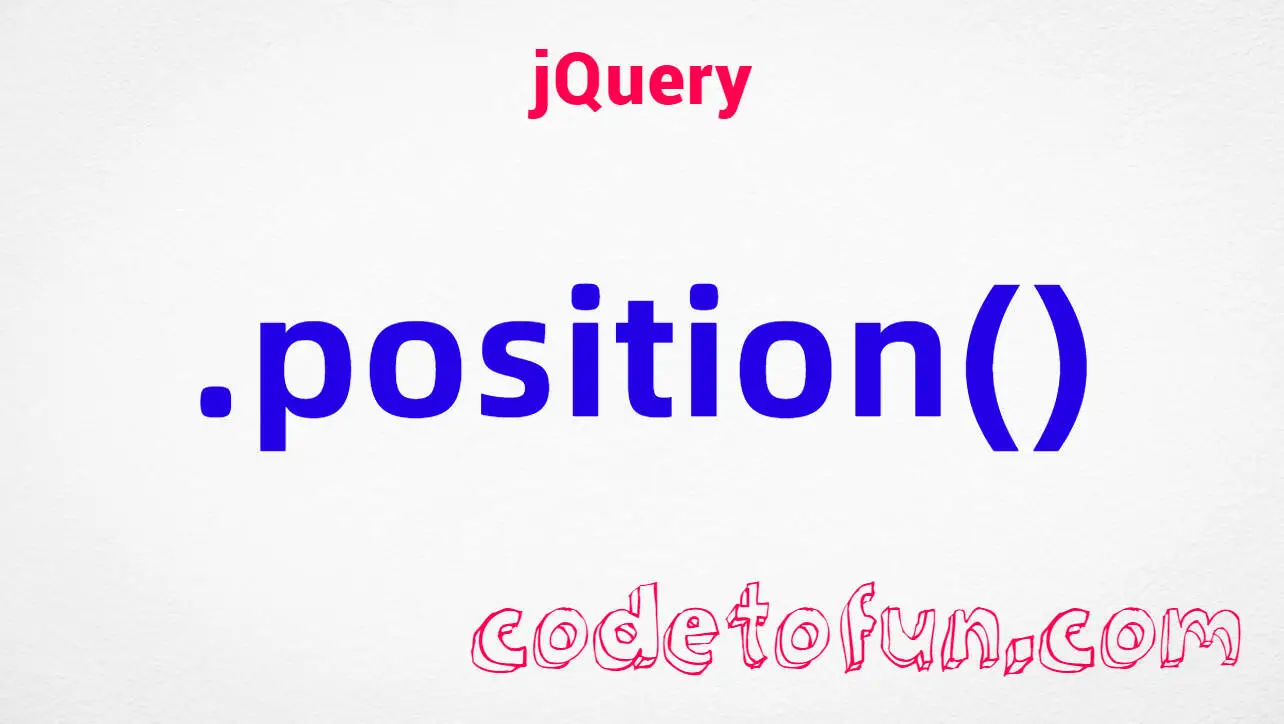
jQuery Basic
jQuery Ajax Events
- jQuery ajaxComplete
- jQuery ajaxError
- jQuery ajaxSend
- jQuery ajaxStart
- jQuery ajaxStop
- jQuery ajaxSuccess
jQuery Ajax Methods
- jQuery .ajaxComplete()
- jQuery .ajaxError()
- jQuery .ajaxSend()
- jQuery .ajaxStart()
- jQuery .ajaxStop()
- jQuery .ajaxSuccess()
- jQuery jQuery.ajax()
- jQuery jQuery.ajaxPrefilter()
- jQuery jQuery.ajaxSetup()
- jQuery jQuery.ajaxTransport()
- jQuery jQuery.get()
- jQuery jQuery.getJSON()
- jQuery jQuery.param()
- jQuery jQuery.post()
- jQuery .load()
- jQuery .serialize()
- jQuery .serializeArray()
jQuery Keyboard Events
jQuery Keyboard Methods
jQuery Form Events
jQuery Form Methods
- jQuery .blur()
- jQuery .change()
- jQuery .focus()
- jQuery .focusin()
- jQuery .focusout()
- jQuery .select()
- jQuery .submit()
jQuery Mouse Event
- jQuery click
- jQuery contextmenu
- jQuery dblclick
- jQuery mousedown
- jQuery mouseenter
- jQuery mouseleave
- jQuery mousemove
- jQuery mouseout
- jQuery mouseover
- jQuery mouseup
jQuery Mouse Methods
jQuery .position() Method

Photo Credit to CodeToFun
🙋 Introduction
In web development, positioning elements on a page is crucial for creating visually appealing and user-friendly interfaces. jQuery offers a range of methods to facilitate this process, and one such method is the .position() method. This method allows you to retrieve the current position of an element relative to its offset parent. Understanding how to use the .position() method effectively can significantly enhance your ability to manipulate and layout elements on your web pages.
In this guide, we'll explore the .position() method in detail, accompanied by clear examples to help you grasp its utility.
🧠 Understanding .position() Method
The .position() method in jQuery is used to retrieve the current position of an element relative to its offset parent. Unlike the .offset() method, which calculates the position relative to the document, .position() calculates the position relative to the first positioned (not static) ancestor element.
💡 Syntax
The syntax for the .position() method is straightforward:
$(selector).position()📝 Example
Retrieving the Position of an Element:
Suppose you have a <div> element on your page and you want to retrieve its position relative to its offset parent. You can use the
.position()method as follows:index.htmlCopied<div id="target" style="position: relative; left: 50px; top: 30px;"></div>example.jsCopiedvar position = $("#target").position(); console.log("Left: " + position.left + ", Top: " + position.top);This will log the left and top position of the #target element relative to its offset parent.
Positioning Elements Dynamically:
You can use the
.position()method to dynamically position elements based on their current position. For instance, let's position a tooltip relative to a button:index.htmlCopied<button id="btn">Hover Me</button> <div id="tooltip" style="display: none;">Tooltip Content</div>example.jsCopied$("#btn").hover(function() { var btnPosition = $(this).position(); $("#tooltip").css({ top: btnPosition.top + $(this).outerHeight(), left: btnPosition.left }).fadeIn(); }, function() { $("#tooltip").fadeOut(); });This will display a tooltip below the button when hovered over.
Handling Elements Within Containers:
When dealing with elements inside containers with different positioning contexts, the
.position()method provides accurate positioning relative to the container. For example:index.htmlCopied<div id="container" style="position: relative;"> <div id="inner" style="position: absolute; top: 20px; left: 20px;"></div> </div>example.jsCopiedvar position = $("#inner").position(); console.log("Left: " + position.left + ", Top: " + position.top);This will log the position of the #inner element relative to its offset parent (#container).
🎉 Conclusion
The jQuery .position() method is a valuable tool for retrieving the position of elements relative to their offset parents. Whether you need to dynamically position elements, handle elements within containers, or perform other layout-related tasks, this method provides a convenient solution.
By mastering its usage, you can create more flexible and visually appealing web interfaces effortlessly.
👨💻 Join our Community:
Author

For over eight years, I worked as a full-stack web developer. Now, I have chosen my profession as a full-time blogger at codetofun.com.
Buy me a coffee to make codetofun.com free for everyone.
Buy me a Coffee











